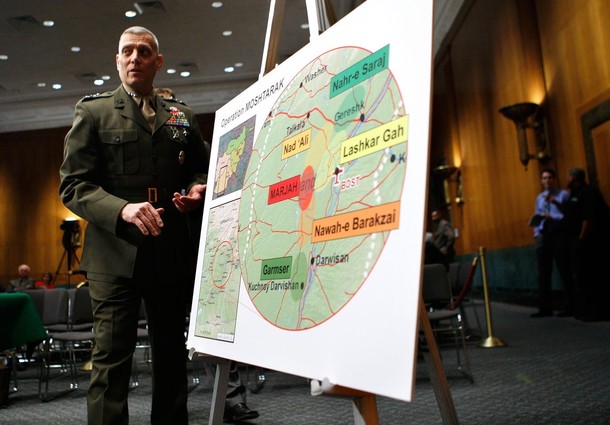
The battle for the Helmand provincial town/city (population around 80,000) is now well underway. It has been advertised as the center of the current “surge” in Afghanistan, an entirely unveiled reference to and comparison with the 2007 exercise in Iraq that lowered the level of violence there sufficiently. It is also the new centerpiece of the American COIN (counterinsurgency ) doctrine in Afghanistan. As goes Marja (or Marjah, depending on who is writing it), so well may go the U.S. effort to Afghanicize the war: like the 2007 surge in Iraq, Marja may well be the substantive opening of the process of Afghanization of the war (turning over responsibility for conducting the war to the Afghans and thus providing a pretext for American withdrawal).
So how is it going? On the face of reporting, it seems to be going pretty well. Most of Marja has been taken by the Marines, and despite continuing Taliban resistance, the battle seems to be going well, at least as measured in comparative casualties and other battlefield measures. Unlike the experience three years ago in Iraq, however, no one is quite ready to report the “light at the end of the tunnel” in Marja and the war more generally. As one State Department official on the scene summarized it, “We are just in the opening act” in Marja. The real challenge is still ahead of us.” He adds, “Marja will be a test for everyone.” (The quotes are from today’s Washington Post.)
Such circumspection is commendable. The heart of a successful COIN campaign is not the ability to dislodge the opposition from some piece of territory for a time, although doing so initially is necessary at the beginning in order to be able to do the real, decisive job of political conversion of the population away from the insurgents and toward the government. Marja has not, for a long time, been exactly a hotbed of support for the Karzai government, or any other regime operating out of Kabul. That process requires a long, patient process of convincing a skeptical population that loyalty to your side beats loyalty to the other side, generally because your side makes life better than it was when your opponents were in charge. Moreover, that conversion must be complete enough so that the target population will resist the return of the currently vanquished Taliban when, inevitably, American forces leave and only Afghan government forces remain.
That conversion, if it is possible at all, will take time. Among Afghans in the area, there is apparent distrust of and suspicion about the central government–a phenomenon not uncommon throughout the country. As if to fuel that dynamic, the new provincial governor on his way to Kabul “recently returned to Afghanistan after 15 years in Germany.” In the American South after the Civil War, such governors were called “carpetbaggers” and were widely suspected and opposed. Maybe the situation is different in Marja. Possibly it is not.
The natives, of course, know that it is dangerous to switch sides too fast, and they are obviously not entirely convinced who the good and bad guys are. As one Marjan told the Post reporter, “We are afraid of the Taliban and we’re afraid of the Marines.” Probably not an imprudent attitude, and one that likely can only be overcome by a long, patient, benign, and positive experience with our side.
The Americans appear to understand this and are trying to convince the natives that we do. As a Marine commander is reported to have assured a group of Marjans, “We’re going to be here for many months.” The audience was apparently skeptical, and their skepticism will only dissipate as many months pass and the Marines are still there. The question is how long the Marines will stay. Factors militating toward shortening their commitment include their need elsewhere in the country and the desire for the United States to withdraw from the country.
So, how is the “opening act” in Marja going? At one level, pretty well, but that is obviously only part of the story by which a judgment about this application of “surginess” (apologies to the Colbert Report) can be rendered. At this point, the real answer is we don’t know how the contest for the loyalty–the hearts and minds–of the Marjans is going, and we won’t know for a fairly long time. It would probably be better to ask the question a year or so from now, when there will be some indication of what the citizens of Marja feel. Unfortunately, our attention span toward Marja will probably have been exceeded by then, and we will be on to asking different questions. At that, even a year may not be long enough: it can be argued (I have argued it) that the success of the surge in 2007 in Iraq will not really be known until fairly well after the American withdrawal is complete and the shape of postwar Iraq has settled in. The same likely will be true in Afghanistan. That is not a very satisfying answer and certainly not a very politically salable reply, but at least it is an honest answer.
Donald M. Snow, Professor Emeritus at the University of Alabama, is the author of over 40 books on foreign policy, international relations and national security topics. This essay was originally published at his blog What After Iraq? Photo credit: Getty Images.
Image: marja-briefing.jpg
